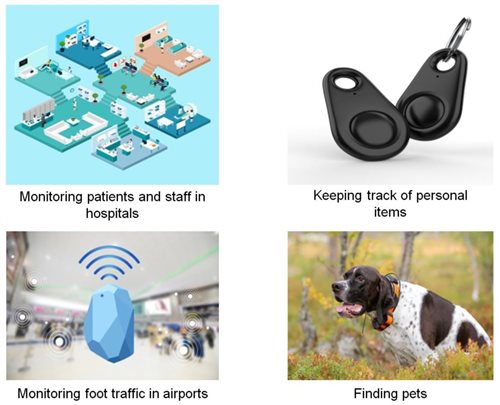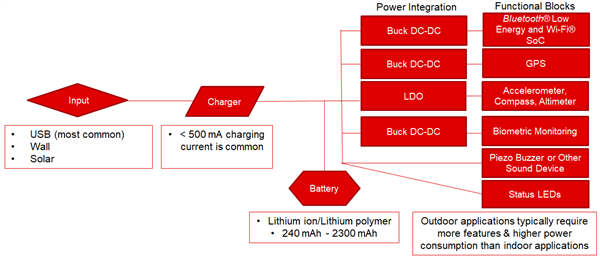SSZT264 august 2020 BQ21061 , BQ24040 , BQ25155 , BQ25619
Real-time location systems (RTLS) enhance the lives of consumers and businesses by making everyday routines smarter through accurate, location tracking technology such as GPS and Bluetooth® Low Energy. RTLS trackers eliminate the stress of losing belongings such as luggage or pets using long-distance GPS tracking. RTLS trackers also enhance businesses with Bluetooth® Low Energy beacons to monitor customer traffic, employee patterns and the location of equipment, which can help identify process bottlenecks and improve customer experience. These applications are just the beginning for RTLS trackers, and designing RTLS with rechargeable batteries can help you get the most out of the systems.
In this article, I will highlight the benefits of rechargeable batteries in RTLSs and explain how TI chargers solve design challenges associated with implementing rechargeable batteries in RTLSs.
The benefits of rechargeable RTLS
Rechargeable RTLS designs are useful in large-scale applications with devices that do not have access to a direct power supply. The area design advantages of RTLSs such as:
- Eliminating the need to buy and replace hundreds of primary cell batteries.
- The freedom to place devices anywhere with no need for a direct power source.
- The ability to maximize possible device locations by creating smaller designs through the implementation of compact charger integrated circuits (ICs).
In addition to large-scale applications, rechargeable RTLS is advantageous in consumer electronics, such as personal item tracking devices and smart dog collars. With rechargeable RTLS, customers can:
- Fully charge a battery in five hours.
- Never worry about losing their keys, wallets or pets because the batteries in the RTLS are dead.
Figure 1 highlights different applications of rechargeable RTLSs.
 Figure 1 Rechargeable RTLS applications
Figure 1 Rechargeable RTLS applicationsRechargeable RTLS design challenges
Indoor and outdoor RTLS devices are usually designed to be aesthetic and small for portability, and designing your system with power integrated battery chargers helps achieves those two design requirements. Chargers with power integration include power rails on the device, such as an LDO, load switch and low power buck convertors, which provide the correct voltages for other components in the circuit. Incorporating power rails into the charger reduces the overall number of components and helps you achieve small, aesthetic designs.
Finally, it requires effort and labor costs to collect and recharge RTLS devices, especially for large-scale applications, so designing your device with efficient power consumption is critical. Choosing a charger with very low quiescent current minimizes power consumption and increases battery time. In addition, chargers with load switches can cut off power to blocks that are not being used which also reduces power consumption.
 Figure 2 Rechargeable RTLS block diagram for pet trackers
Figure 2 Rechargeable RTLS block diagram for pet trackersTI chargers for rechargeable RTLS devices
TI’s BQ24040 and BQ21061 are two linear chargers that can help address common design challenges. The BQ24040 satisfies charging requirements for simpler RTLS devices. It is 4mm2 and its 1µA standby current helps extend battery life leading to more uptime. This device is useful for RTLS applications in which people rarely interact with the device, such as Bluetooth® Low Energy beacons. The BQ21061 is useful in RTLS devices such as smart dog collars. The I2C interface enables easy configuration of charging properties, while the LDO adds an extra power rail to minimize space. The power path feature provides a ship-mode option.
| Feature | BQ24040 | BQ21061 | BQ25619 |
|---|---|---|---|
| Standby current | 1 µA | 470 nA | 9 µA |
| Ship mode | No | Yes | Yes |
| Charge current range | 100 mA - 1 A | 1.25 mA - 500 mA | 20 mA - 1.5 A |
| Standalone or I2C | Standalone | I2C | I2C |
| Size | 2.00 mm x 2.00 mm | 2.00 mm x 1.60 mm | 4.0 mm x 4.0 mm |
| Power path | No | Yes | Yes |
| LDO | No | Yes | No |
In addition to the previously mentioned applications, herd tracking is a growing opportunity for RTLSs that requires a large-scale solution for animal tracking. By placing RTLS devices similar to the dog collars on farm animals such as cows, farmers are able to monitor the health and location of every animal in a herd to make smarter, more informed decisions. Designers for this application are implementing highly integrated chargers with long battery life, such as the BQ25155, in order to efficiently collect biometric data. As the need for RTLS continues to grow, design engineers are turning to highly integrated battery chargers to keep up with more demanding device requirements.
Additional resources
- Read these technical articles:
- “How to choose the right linear charger for your application.”
- “Revolutionizing RTLS with Bluetooth low energy technology.”
- Read the application report, “BQ21061 Two Layer Small Form Factor Design for Cost Optimized PCBs.”
- Search for the right TI battery charger IC for your next design.